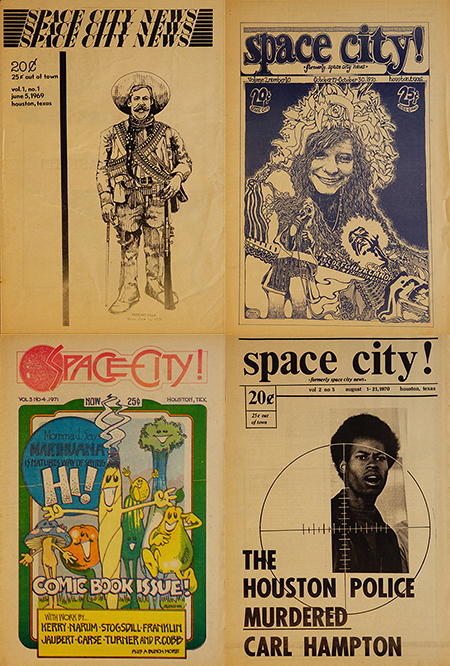Houston’s underground paper is now digitized; soon to be a book.

Space City! covers, clockwise from top left: Vol. 1, No. 1; Vol. 2, No. 10;
Vol. 2, No. 5; Vol. 3, No. 4.
AUSTIN — On March 11, 2020, I shipped a near-complete collection of Space City! newspapers to Indiana to be scanned for preservation and display at the Internet Archive. Little did I know that the issues would arrive just days before the library shut down because of Covid19. For two and a half months, Space City! sat in quarantine.
On June 1, the library began to staff up again. Soon, the newspapers took on a digital life, a collection accessible to activists, academics (and the general public) interested in the transformative period chronicled on the pages of Houston’s historic underground paper. The work is now complete. Each of the 103 papers can be viewed in its entirety here.
Three issues are still missing. If you have any of them — or know of their whereabouts — please let us know.
- Volume 3, Issue 3, November 11, 1971. Cover illustration: Mayor Louie Welch with money
- Volume 3, Issue 32, January 10, 1972. Cover illustration: People dancing.
- Volume 4, Issue 5, July 4, 1972. Cover image unknown.
The New Journalism Project is proud to be part of maintaining this historical record.
The New Journalism Project is proud to be part of maintaining this historical record. Space City! was cousin to The Rag in Austin and three members of the original collective responsible for launching Space City! had cut their teeth launching The Rag in October 1966. The Houston paper had a shorter life, launched on June 5, 1969, with its final issue published August 3, 1972, but it had great impact. In many ways, Space City! staffers had a harder life as they survived a level of overt repression in Houston that Ragstaffers were spared in Austin.
We appealed for funds in December of 2019 for this project and again later with a Go Fund Me site. Contributions have been generous and we are clearly moving forward with this project. We intend to request that Reveal Digital add this digital collection to their Independent Voices collection online where every issue of The Rag can be seen.
With digital scans now available, NJP can move forward with a catalogue of contents. That is the next step toward publication of a book on Houston’s historic underground paper, similar to the widely-acclaimed book Celebrating The Rag: Austin’s Iconic Underground Newspaper that was published in October 2016.
NJP has been busy with projects that can be undertaken from the safety of our homes.
NJP has been busy with projects that can be undertaken from the safety of our homes. An upsurge in posts to the The Rag Blog, a recent return to Thorne Dreyer’s Rag Radio interviews (now conducted outside of the KOOP studios), and the publication of a new book, Stories from Wimberley 1928-29. NJP has also partnered with Dorothy Dickie, a filmmaker who is seeking to finalize a documentary on Liberation News Service (LNS).
These are unprecedented times with a pandemic and a nationwide and global uprising in the aftermath of George Floyd’s murder in Minneapolis. Some of us have been unable to be in the streets. The historical events, particularly those that took place in Houston with the murder of Carl Hampton, are important.
Houston, now the nation’s most diverse city, was at the time of Space City! a place of active KKK bombings and police repression of Black activists. That history was not well documented by major media, what we called straight media, but it was reported in Space City! The Space City! thumbnails in the archive (and above) tell a story of a previous period of uprising.
Read more about the Space City! project here.
[Alice Embree is an Austin writer and activist who serves on the board of directors of the New Journalism Project, is associate editor of The Rag Blog, and was a founder of The Rag, Austin’s legendary underground paper, in 1966.]
- Read more articles by Alice Embree on The Rag Blog.


















Great work, Alice! Preserving people’s history is vital to the future. I’m eager to dig into the Space City! archive.
Soon to be a book maybe requires a definition of “soon.” First, we’re going to create a content directory with the help of an intern and a computer wizard. But, having these issues available is Step 1. As in, Mission Accomplished, and I’m not quoting anyone.